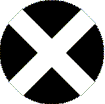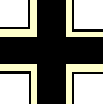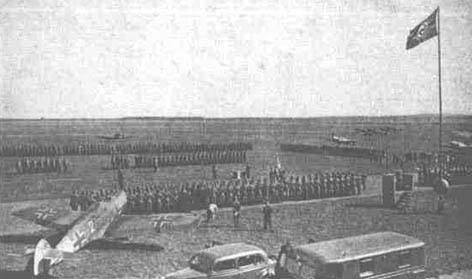Spain


Luis Alcocer Moreno Abellá
Spain


Luis Alcocer Moreno Abellá
On 16 June 1938, the pilots of the first fighter course held in the Nationalist zone were graduated. The large number of accidents caused by new and inexperienced Fiat pilots in December and January had showed that it was essential to set up a school of this type.
Gallur was chosen as the aerodrome and Maggiore Guido Nobili and teniente Ramón Senra Àlvarez (from Group 2-G-3), were posted there as instructors.
The first fighter course lasted for two months and was attended by 22 pupils. Of these, six were sent to 2-G-3 (José Luis Bernal de Mérida, José M.a Etayo Elizondo, Luis Alcocer Moreno Abellá, Antonio Manrique Garrido, Abundio Cesteros García and Diego Vigueras), eight to 3-G-3 (Heraclio Gautier Larrainzar, Enrique Munaiz de Brea, Fernando Arrechea Belzunce, Carracido, Acuña, Alonso Fariña, P. Téllez Rivas and Epelde), and of the remainder four were posted to fly He 51s, three to the He 45s and one to the Aero 101s.
In the morning on 2 September, a formation of nine R-Zs, escorted by a similar number of I-15s, were attacked by 18 Spanish-flown CR.32s near Monterrubio de la Serena as they returned from a bombing mission. Minutes later nine SBs from 4a Escuadrilla of Grupo No 24, escorted at a distance by 11 I-16s Type 10, hove into view too. The CR.32s concentrated on the Tupolev bombers and their monoplane fighter escorts. In a single attack, capitán Ángel Salas (2-G-3) destroyed three Katiuskas, and then capped this by damaging the I-16 Type 10 flown by the leader of the 1a Escuadrilla Grupo de Moscas No 21 that was escorting them. This pilot, teniente José Redondo Martín (the son of the former mayor of Madrid, Cayetano Redondo Aceña), took to his parachute and was guarded by Salas until he had almost reached the ground. Salas, before flying away, raised an arm in the Fascist salute, and Redondo (I-16 ‘CM-214’) responded in a similar manner with a clenched fist.
Salas noted in his logbook:
“After 50 minutes on patrol I spotted nine “Martin bombers” that were a little higher than us heading in the direction of our lines. I gained height as I flew towards them, cutting off their escape route. As they returned after bombing Monterrubio, I attacked the bomber on the left in the first section, setting his left engine on fire. I then hit the left engine of the leader’s aircraft, setting it on fire too, and the third bomber suffered the same fate. Then I fired straight up at the leader of the second flight, and his aircraft started trailing white smoke. It was then that I noticed some Ratas, so I attacked one. After a long fight it also started to trail smoke, and the pilot took to his parachute. He landed close to his aircraft, north of Belalcázar. During his descent I saluted him and he saluted me back.”Salas had shot down four aircraft in five minutes. A number of the crewmen from the downed bombers took to their parachutes, only to be killed as they floated down, or immediately after landing, by groundfire from Moroccan troops fighting in this area. Ricote, commander of 4a/24 and flying the SB damaged by Salas, force-landed his bomber on Almodóvar airfield after having one of his engines shot out. This event must have been well known in the Government zone, as it was reported from several sources.
“The part played by the group under your command in today's operation has filled me with pride and it gives me great satisfaction to have people under my command who know how to make the best use of prevailing circumstances. It gives me great pleasure to congratulate you personally, and the whole of your unit, to whom I hope you will convey this message.”
On 9 February 1939, five I-15s were claimed by Spanish pilots near Peñarroya, in Andalusia. Two were credited to capitán Arístides García López (8-E-3), taking his overall tally to 17, and one each to Juan Frutos Rubio, teniente Antonio Manrique (1-E-3) and teniente Alcocer - the latter two pilots each ‘made ace’ with these successes.
This was the last aerial combat for the CR.32 in Spain
Alcocer ended the Spanish Civil War with 5 biplane victories.
He later volunteered for combat in Russia and was part of the 1a Escuadrilla Azul, (Escuadrilla Expedicionaria) which was formed with 17 pilots with Salas as the Commander. Some of them were veterans of the Spanish Civil War and had a combined score of 79 aerial victories.
The unit crossed into France on 24 July 1941, later arriving in Germany in late part of the month.
They were assigned to training at the Jagdfliegerrschule 1 at Werneuchen near Berlin.
After completing their training on Bf 109 Es, the 1a Escuadrilla left for Russia on 26 September.
At first, the Spanish pilots were worried that they would arrive late to see any action, since they were kept informed of the progress of the German advance towards Moscow.

The 1a Escuadrilla received a total of 12 Bf 109 E-4s and –7s and they were assigned to JG 27, VIII FliegerKorps of LuftFlotte 2. They were known as the “15 Spanische Staffel”, and they were structured into three påatrols, with five pilots each and a staff:
Staff: CO commendante Ángel Salas and second in command commendante José Muñoz Jiménez.
1st Patrol: capitán Arístides García and tenientes Alfonso Rubial, Ángel Mendoza, Ricardo Bartolomé and Abundio Cesteros.
2nd Patrol: capitán Javier Allende and tenientes Alcocer, José Lacour, Javier Busquets and Alfonso Gracia-Rodriguez.
3rd Patrol: capitán Carlos Bayo and tenientes Esteban Ibarreche, Emelio O’Connor, Manuel Kindelán and Demetrio Zorita.
The Spanish unit started to fly their first combat operations on 2 October. Escorting German bombers and reconnaissance aircraft, they operated from 12 different airfields.
The first mission in which Spanish pilots took part was on 2 October, coinciding with the start of Operation Typhoon. They flew 23 individual sorties during the day to escort Henschel Hs 123s and Bf 109s that were carrying out ground attacks against Soviet troops in the Orel area.
That same day, the lst Squadron suffered its first casualty when, after finishing an escort mission of the Hs 123s, commendante Ángel Salas, teniente Alfonso Rubial, teniente Alcocer and capitán Javier Allende entered into combat with a formation of 22 MiG-3s, several Polikarpov I-16s and several DB-3 bombers 6 kilometres north of Moschna. Despite the clash between the Soviet and Spanish aircraft, there were no casualties in either formation. However, Teniente Alcocer (Bf 109 E-7 WNr. 1390) became disoriented and ran out of fuel after flying for over an hour, and he tried to make an emergency landing, during which he pulled out his wheels and was killed by the collision with his aircraft's collimator (a rule for crash landings was to never deploy the wheels and to always remove the collimator).
Teniente Alcocer’s body was taken to Werneuchen in a Ju 52/3m.
At the time of his death, Alcocer was credited with 5 biplane victories.
Claims:
| Kill no. | Date | Time | Number | Type | Result | Plane type | Serial no. | Locality | Unit |
| 1938 | |||||||||
| ? | 02/09/38 | morning | 1 | I-16 | Destroyed | CR.32 | Zújar area | 2-G-3 | |
| 1939 | |||||||||
| 5 | 09/02/39 | 1 | I-15 (a) | Destroyed | CR.32 | near Peñarroya | 2-G-3 |
Biplane victories: 5 destroyed.
TOTAL: 5 destroyed.
(a) Five I-15s were claimed by Spanish pilots. These were the last CR.32 claims in Spain.
Sources:
Air Aces - Christopher Shores, 1983 Presidio Press, Greenwich, ISBN 0-89141-166-6
Air War over Spain - Jesus Salas Larrazabal, 1974 Ian Allan Ltd, Shepperton, Surrey, ISBN 0-7110-0521-4
Deutsche Luftwaffe Losses & Claims -series - Michael Balss
Fiat CR.32 Aces of the Spanish Civil War - Alfredo Logoluso, 2010 Osprey Publishing, Oxford, ISBN 978-1-84603-983-6
Joaquin Garcia-Morato - Best Ace of Spanish Civil War (WWII Ace Stories) - Mihail Zhirohov, 2003
The ‘Blue Squadrons’ – The Spanish in the Luftwaffe, 1941-1944 – Juan Arráez Cerdá and Eduardo Manuel Gil Martínez 2023 Helin & Company Limited, ISBN 978-1-804512-39-5
Wings Over Spain - Emiliani Ghergo, 1997 Giorgio Apostolo Editore, Milano
Additional information kindly provided by Alfredo Logoluso and Ondrej Repka.


